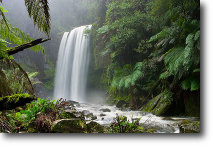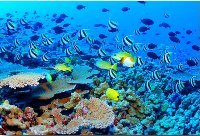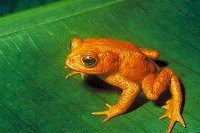Biodiversity
Author and Page information
- This page: https://www.globalissues.org/issue/169/biodiversity.
- To print all information (e.g. expanded side notes, shows alternative links), use the print version:
The variety of life on Earth, its biological diversity is commonly referred to as biodiversity. The number of species of plants, animals, and microorganisms, the enormous diversity of genes in these species, the different ecosystems on the planet, such as deserts, rainforests and coral reefs are all part of a biologically diverse Earth. Appropriate conservation and sustainable development strategies attempt to recognize this as being integral to any approach. Almost all cultures have in some way or form recognized the importance that nature, and its biological diversity has had upon them and the need to maintain it. Yet, power, greed and politics have affected the precarious balance.
9 articles on “Biodiversity” and 2 related issues:
Why Is Biodiversity Important? Who Cares?
 Why is Biodiversity important? Does it really matter if there aren’t so many species?
Why is Biodiversity important? Does it really matter if there aren’t so many species?
Biodiversity boosts ecosystem productivity where each species, no matter how small, all have an important role to play.
For example, a larger number of plant species means a greater variety of crops; greater species diversity ensures natural sustainability for all life forms; and healthy ecosystems can better withstand and recover from a variety of disasters.
And so, while we dominate this planet, we still need to preserve the diversity in wildlife.
Read “Why Is Biodiversity Important? Who Cares?” to learn more.
Loss of Biodiversity and Extinctions
 It has long been feared that human activity is causing massive extinctions. Despite increased efforts at conservation, it has not been enough and biodiversity losses continue. The costs associated with deteriorating or vanishing ecosystems will be high. However, sustainable development and consumption would help avert ecological problems.
It has long been feared that human activity is causing massive extinctions. Despite increased efforts at conservation, it has not been enough and biodiversity losses continue. The costs associated with deteriorating or vanishing ecosystems will be high. However, sustainable development and consumption would help avert ecological problems.
Read “Loss of Biodiversity and Extinctions” to learn more.
Nature and Animal Conservation
 Preserving species and their habitats is important for ecosystems to self-sustain themselves.
Preserving species and their habitats is important for ecosystems to self-sustain themselves.
Yet, the pressures to destroy habitat for logging, illegal hunting, and other challenges are making conservation a struggle.
Read “Nature and Animal Conservation” to learn more.
Climate Change Affects Biodiversity
 Rapid global warming can affect an ecosystems chances to adapt naturally.
Rapid global warming can affect an ecosystems chances to adapt naturally.
The Arctic is very sensitive to climate change and already seeing lots of changes. Ocean biodiversity is already being affected as are other parts of the ecosystem.
Read “Climate Change Affects Biodiversity” to learn more.
Coral Reefs
 One type of ecosystem that perhaps is neglected more than any other is perhaps also the richest in biodiversity—the coral reefs.
One type of ecosystem that perhaps is neglected more than any other is perhaps also the richest in biodiversity—the coral reefs.
Coral reefs are useful to the environment and to people in a number of ways. However, all around the world, much of the world’s marine biodiversity face threats from human and activities as well as natural. It is feared that very soon, many reefs could die off.
Read “Coral Reefs” to learn more.
Addressing Biodiversity Loss
 At the 1992 UN Conference on Environment and Development (the
At the 1992 UN Conference on Environment and Development (the Earth Summit
), the Convention on Biological Diversity (CBD) was born. 192 countries, plus the EU, are now Parties to that convention. In April 2002, the Parties to the Convention committed to significantly reduce the loss of biodiversity loss by 2010.
Perhaps predictably, that did not happen. Despite numerous successful conservations measures supporting biodiversity, the 2010 biodiversity target has not been met at the global level. This page provides an overview on how the attempts to prevent biodiversity loss is progressing.
Read “Addressing Biodiversity Loss” to learn more.
Biosafety Protocol 1999
The February 1999 Biodiversity Protocol meeting in Colombia broke down because USA, not even a signatory to the Convention on Biological Diversity, to which the protocol is meant to be part of, and five other countries of the "Miami Group" felt that their business interests were threatened. The safety concerns were unfortunately overridden by trade concerns. Some technological advances, especially in genetically engineered food, have been very fast paced and products are being pushed into the market place without having been proven safe. All over the world, concerned citizens and governments have been trying to take precautionary measures. However, 1999 was not a successful year in that respect.
Read “Biosafety Protocol 1999” to learn more.
Biosafety Protocol 2000
A Biosafety Protocol meeting was hosted in Montreal, Canada January 24 to January 28. Compared to the fiasco of the previous year, this time, there had been a somewhat successful treaty to regulate the international transport and release of genetically modified organisms to protect natural biological diversity. However, there were a number of important and serious weaknesses too.
Read “Biosafety Protocol 2000” to learn more.
Biodiversity Links for more Information
Read “Biodiversity Links for more Information” to learn more.
Climate Change and Global Warming
 The climate is changing. The earth is warming up, and there is now overwhelming scientific consensus that it is happening, and human-induced. With global warming on the increase and species and their habitats on the decrease, chances for ecosystems to adapt naturally are diminishing. Many are agreed that climate change may be one of the greatest threats facing the planet. Recent years show increasing temperatures in various regions, and/or increasing extremities in weather patterns.
The climate is changing. The earth is warming up, and there is now overwhelming scientific consensus that it is happening, and human-induced. With global warming on the increase and species and their habitats on the decrease, chances for ecosystems to adapt naturally are diminishing. Many are agreed that climate change may be one of the greatest threats facing the planet. Recent years show increasing temperatures in various regions, and/or increasing extremities in weather patterns.
This section explores some of the effects of climate change. It also attempts to provide insights into what governments, companies, international institutions, and other organizations are attempting to do about this issue, as well as the challenges they face. Some of the major conferences in recent years are also discussed.
Read “Climate Change and Global Warming” to learn more.
Environmental Issues
 Environmental issues are also a major global issue. Humans depend on a sustainable and healthy environment, and yet we have damaged the environment in numerous ways. This section introduces other issues including biodiversity, climate change, animal and nature conservation, population, genetically modified food, sustainable development, and more.
Environmental issues are also a major global issue. Humans depend on a sustainable and healthy environment, and yet we have damaged the environment in numerous ways. This section introduces other issues including biodiversity, climate change, animal and nature conservation, population, genetically modified food, sustainable development, and more.
Read “Environmental Issues” to learn more.
Author and Page Information
- Created:
- Last updated:
 Global Issues
Global Issues